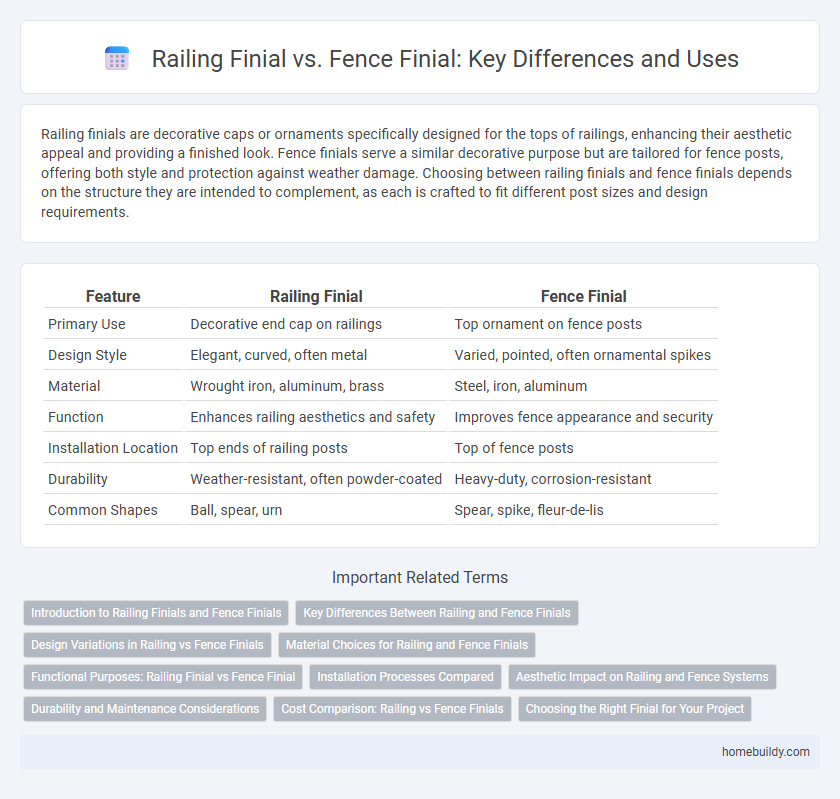Railing finials are decorative caps or ornaments specifically designed for the tops of railings, enhancing their aesthetic appeal and providing a finished look. Fence finials serve a similar decorative purpose but are tailored for fence posts, offering both style and protection against weather damage. Choosing between railing finials and fence finials depends on the structure they are intended to complement, as each is crafted to fit different post sizes and design requirements.
Table of Comparison
| Feature | Railing Finial | Fence Finial |
|---|---|---|
| Primary Use | Decorative end cap on railings | Top ornament on fence posts |
| Design Style | Elegant, curved, often metal | Varied, pointed, often ornamental spikes |
| Material | Wrought iron, aluminum, brass | Steel, iron, aluminum |
| Function | Enhances railing aesthetics and safety | Improves fence appearance and security |
| Installation Location | Top ends of railing posts | Top of fence posts |
| Durability | Weather-resistant, often powder-coated | Heavy-duty, corrosion-resistant |
| Common Shapes | Ball, spear, urn | Spear, spike, fleur-de-lis |
Introduction to Railing Finials and Fence Finials
Railing finials serve as decorative caps for the tops of railings, enhancing safety while providing an elegant finish to staircases, balconies, and decks. Fence finials, on the other hand, are typically designed to protect fence posts from weather damage while adding ornamental character to garden and property boundaries. Both railing and fence finials come in a variety of materials such as wrought iron, brass, or aluminum, each tailored to specific functional and aesthetic requirements.
Key Differences Between Railing and Fence Finials
Railing finials are typically designed to top handrails, featuring sleek, rounded shapes that enhance interior or exterior staircases, while fence finials cap fence posts with more robust, decorative, and weather-resistant designs to withstand outdoor conditions. The key differences lie in their size, material durability, and aesthetic purpose: railing finials are often smaller, crafted from materials like brass or wrought iron for elegance, whereas fence finials prioritize sturdiness using metals like steel or aluminum to provide security and durability. Installation methods also differ, with railing finials usually attached via screws or adhesives suited for indoor use, contrasting fence finials which require more secure fastening to endure environmental exposure.
Design Variations in Railing vs Fence Finials
Railing finials often feature intricate design variations tailored to complement indoor or stairway railings, showcasing elegant, smaller-scale motifs such as scrolls, fleur-de-lis, or geometric shapes. Fence finials, by contrast, tend to emphasize durability and bold aesthetics with larger, weather-resistant designs like spearheads, ball tops, or gothic points suited for exterior protection. The design variations reflect each finial's functional context, balancing decorative appeal with structural requirements.
Material Choices for Railing and Fence Finials
Railing finials commonly feature materials like wrought iron, stainless steel, and aluminum, offering durability and corrosion resistance tailored for staircases and balconies. Fence finials often utilize cast iron, galvanized steel, and ornamental brass, prioritizing robust outdoor weather resistance and decorative appeal along property boundaries. Both finial types require materials chosen for structural integrity and aesthetic compatibility with their respective installations.
Functional Purposes: Railing Finial vs Fence Finial
Railing finials primarily serve to cap the top of railings, providing protection against weather damage and adding safety by preventing snagging or injury. Fence finials function mainly as decorative elements and deterrents, often featuring pointed designs to discourage climbing and enhance perimeter security. Both finial types contribute to structural integrity but are optimized for their respective applications in safety and aesthetics.
Installation Processes Compared
Railing finials typically require precise alignment and secure fastening to balusters or posts, often involving drilling or welding for a stable fit on staircases or balconies. Fence finials generally have simpler installation, usually sliding over or being screwed onto post tops, designed for outdoor exposure and ease of replacement. Both types demand rust-resistant materials, but railing finials often involve more intricate customization to match architectural styles.
Aesthetic Impact on Railing and Fence Systems
Railing finials enhance vertical post aesthetics with intricate designs that create a refined, cohesive look, complementing interior and exterior decor more prominently than fence finials. Fence finials focus on durability and security, often featuring simpler, robust shapes that emphasize protection over ornamental detail. The aesthetic impact of railing finials is more pronounced, elevating architectural elegance, whereas fence finials prioritize functional appearance combined with a subtle decorative touch.
Durability and Maintenance Considerations
Railing finials, typically crafted from durable materials like wrought iron or stainless steel, offer enhanced resistance to weathering and corrosion compared to many fence finials, which are often made from lighter metals or plastic composites. The robust construction of railing finials reduces the frequency of maintenance, requiring only occasional cleaning and rust prevention treatments, whereas fence finials may need more regular upkeep due to their exposure to harsher outdoor conditions and less resilient materials. Selecting railing finials ensures long-lasting aesthetic appeal and structural integrity with minimal maintenance effort.
Cost Comparison: Railing vs Fence Finials
Railing finials generally cost more than fence finials due to their intricate designs and materials suited for indoor and architectural settings. Fence finials are typically simpler and made from more durable, weather-resistant materials, making them more affordable and practical for outdoor use. Price variations depend on size, material such as wrought iron or aluminum, and customization options.
Choosing the Right Finial for Your Project
Railing finials and fence finials serve distinct purposes, with railing finials designed primarily for indoor or balcony railings, offering decorative topping and safety by capping posts, while fence finials are typically used outdoors to enhance security and aesthetic appeal on fence posts. Selecting the right finial depends on factors such as the installation environment, material durability requirements, and design compatibility with existing structures. Prioritize weather-resistant materials like wrought iron or stainless steel for outdoor fence finials and opt for elegant, detailed designs using bronze or brass for indoor railing finials to ensure longevity and cohesive style.
Railing finial vs Fence finial Infographic

 homebuildy.com
homebuildy.com